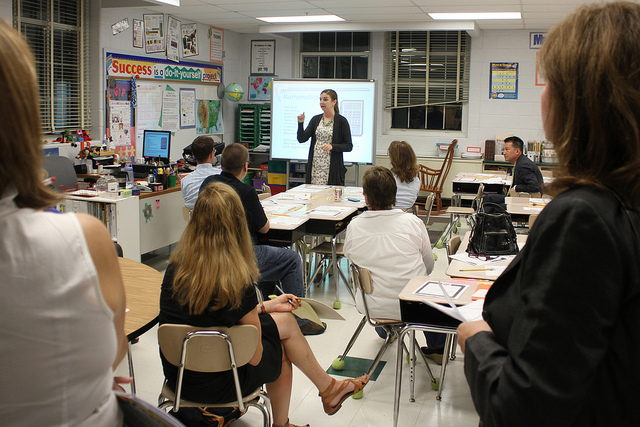 There is nothing that makes a teacher happier than really involved parents and I have to say that I feel really lucky to have parents that are not only involved, but also really supportive. I am confident to say that many teachers feel the same way. Having parents that are well informed about their child’s academics and day-to-day schooling is crucial in order to have a successful school year.
There is nothing that makes a teacher happier than really involved parents and I have to say that I feel really lucky to have parents that are not only involved, but also really supportive. I am confident to say that many teachers feel the same way. Having parents that are well informed about their child’s academics and day-to-day schooling is crucial in order to have a successful school year.
This week, I held my back-to-school night at the dual language school I work and I was pleased to see the majority of my parents attend. However, what I loved the most were the great questions they had for me. In this post, I want to address some of those questions and at the same time encourage you (parents/guardians) to ask those types of questions whether your child attends a dual immersion program or not. Here are some of those questions:
- What reading level should my child be in both languages at this point in the school year and where should he/she be at the end of the school year?
This is very important! My school uses reader’s workshop where each student reads a different book depending on their reading level (not the ‘one book fits all’ model), so parents are always wondering where their children should be. Regardless of your child attending a dual language program or not, as a parent you want to know his/her level. While there are many variables and things to consider, in average there is a ‘letter or Lexile Level’ for each grade (in other words a ‘benchmark’ that he/she should be at). What is fascinating is that children in dual language programs can be at two different levels. For example, a fourth grader may be a level Q in English, but a level S in Spanish. Therefore, ask your child’s teacher about this so that he/she can read books that are really accessible for him/her.
- What type of classroom management do you use in your classroom?
There are a plethora of classroom management approaches and this definitely varies from teacher to teacher. Yet, keep in mind that many schools have a certain ‘culture’ to how they handle behavior issues. I personally do not use/post behaviors on the walls or on a pocket chart (I don’t like shaming children). What I have found throughout the years is that children who were on red were ‘always on red.’ And if you are a parent that knows what I am talking about, is probably because your child was probably one of them…and you hated it. Again, this is my personal and humble approach and by no means I am criticizing other teachers. It is just that classroom management is something that goes hand in hand with a teacher’s personality and tolerance for certain behaviors. This is usually addressed on back to school night and at the beginning of the year on a letter sent home by teachers, but you want details and as a parent you should know how the ‘system’ works.
-What are some different ways to volunteer in the classroom?
I could not make it without parent volunteers. And let’s be honest, you would love to ‘spy’ on your child every once in a while and see how he/she interacts with other peers in the classroom (and yes…you want to spy on the teacher too). Most teachers would have a volunteer list/sign up. Just remember that there are many-many ways to volunteer and help and you don’t necessarily have to come to class (especially if you are a working parent and your job requires you to be at work during normal school hours). I rely on technology for this. I have a classroom website through Shutterfly and send text messages to parents who do not have access to the Internet using Remind 101 (and of course paper for those who request it).
Therefore, SpanglishBaby parents, I know this is a rather small example of great questions I got asked this week. Please make sure you ask them too and if you have any questions you may want to ask me, I would be glad to help. Have you had your back-to-school night? I would love to hear how it went.
Much love and happy questioning,
Kelly
Photo by Woodleywonderworks



Hi Kelly,
Very interesting article. Thank you. I would like to know which is your approach regarding class management.
Hola Maria,
Thank you for your question. Actually, my classroom management and overall teaching style has evolved over the years. When I look back at my first and second year, I see so many things that I could have done differently…but again that is how you learn.
Last year, I had a very challenging class. Don’t take me wrong, I loved my kids, but it was my hardest year as an educator. It tested my limits, patience….I really wondered if teaching was what I was destined to do (imagine how crazy it was!).
So, when I started teaching, I did have a chart with colors (red, yellow, green), then moved to a street light (same thing), but I never personally felt it had any impact. Those who did great, ALWAYS did great, and those who where in read, were ALWAYS in red. Once I moved to CA and changed schools, I was introduced to this entire new philosophy of no names on the board, no charts, no shaming of students. WHAT? I thought, “Yeah right…this is going to work.” It was a steep learning curve as extrinsic rewards were NOT allowed (in the upper graders 4-5)…they could earn some ‘peace time’ to color, read, etc.
Fast forward to last year. I moved to 3rd, and after much research I had to move to a token economy (students earning class $$ for their task/behaviors/etc). While the checkbooks have a credit and debit column, I rarely take money off. I also make a hard….hard conscious effort to praise positive behaviors and channel the negative into positive…Children love to be praised (who does not), so I do it all the time.
Also, at the beginning of each day, we meet to share what I saw the day before (PRAISE something even if I think they were horrible…”I am so proud of ________ for _________.”), and I set a rule to focus on (wait for our turn, no talking while others are sharing etc), EVERY morning I do this….whether is the beginning of end of the school year. Children need to be reminded of the rules….so they are revisited every day.
In summary, I use a token economy (attached to lessons about the economy, taxes, etc), LOTS of positive reinforcement, morning meeting to reinforce a rule and carry it our throughout the day, and no shaming at all….
I know it is a LONG response, but hope it clarify/answered your question.
Abrazos,
Kelly
Ps. Feel free to ask me for more details if you would like.
Kelly,
as the mother of three children, including one who is blind with hearing issues, an IEP and a mother and a father well versed and trained in special education law, I often tell parents who attend my seminar that teachers SAY they want involved parents until such time as we start to ask questions about methodologies (ie for kids who are known to be dyslexic), about compliance with the ” I” in the acronym IEP, assistive technologies and other concepts and information that we know more about than they do. My experience has been that when the parents know more than the teachers, the principal, administrators and the school board about something because they attend educational conferences, disability community events to learn how to effectively advocate, “professionals’” egos gets in the way and parents are labeled, fought, challenged, etc. Agree or disagree? I’m just curious because I truly believe that what schools want is parent volunteers, fundraisers and people to bring in treats for holiday celebrations and not parents who know more about subjects that help their children actually receive their federally guaranteed education as disabled children. Thank you.
Graciela Tiscareno-Sato
Google me with “Future Reflections” to find my advocacy pieces
Dear Graciela,
Thank you for touching on the subject of special education. I read your post and I could not help but agree on many of the points you shared. In reality, and I speak from my own experience, the area of special education is a very ‘touchy’ subject for many teachers because of the risk of litigation. I have felt many times that I had to be extremely careful to what I shared on IEP meetings.
However, I had the pleasure of working at a school where parents were really involved (and I mean ‘really’ involved). Parents were well educated, many had graduate degrees, and they perfectly knew their rights. I became used to having advocates and lawyers present at meetings and I was ok with it. As a matter of fact, I have been pretty outspoken at meetings and I personally would not sign an IEP (as a member) if I did not agree with something….but that is another story. From a teacher standpoint, I feel that many things (if not most) come down to funding. Any time there is a cut in education, special programs and resources are take away from teachers and students. The real question is: Due to the nature and complexity of serving many special educations students, what are schools/government doing to serve them fairly? I doubt you would find someone who having the resources, would deny them to a child who needs them. Unfortunately, many decisions in special ed are based on budget on not on students’ needs.
I can only speak for myself and my own experience and I have to say that yes, many schools want parents to volunteer for fundraisers, but when it gets down to curriculum, and other important decisions, many schools would like to do what they believe is best without much parent involvement. I can only commend you and admire you for really knowing your rights and fight for what you and your child are entitled to. As I have said it to many parents, I would be as involved and very demanding if I had a child with special needs.
My question to you is: What is your plan of action when it comes to speaking to the teacher of your child with special needs? What are you looking for in a teacher?
Thank you again Graciela, and I hope that after this long reply I was able to answer your question.
Kelly
I
By the way, I read your article on VRRF and I was really moved. An inspiration indeed.
Kelly
Typically I don’t study write-up for weblogs, even so need to say that that write-up incredibly required my family to perform therefore! Your own producing style have been stunned my family. Many thanks, good posting.